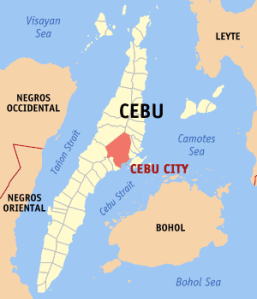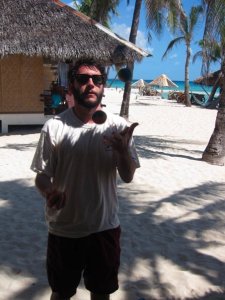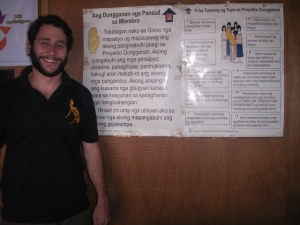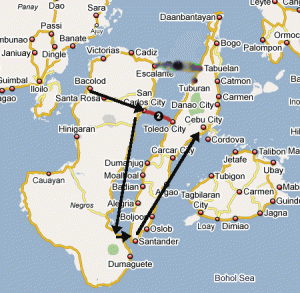 As a Kiva Fellow, I go to the field to interview borrowers about the status of their loan and talk about the business, the family, and their dreams for the future. Usually I do a short write-up to update the Kiva lenders, but sometimes I go overboard and write an essay. This is not representative of most journal entries, but I found her to be such an interesting client that I wanted to share it. I titled this journal update “Glenda’s Business and the Economics of a Half-Hectare Farm.” It only went out to 13 people, so I’m hoping for a larger audience here*: Continue reading
As a Kiva Fellow, I go to the field to interview borrowers about the status of their loan and talk about the business, the family, and their dreams for the future. Usually I do a short write-up to update the Kiva lenders, but sometimes I go overboard and write an essay. This is not representative of most journal entries, but I found her to be such an interesting client that I wanted to share it. I titled this journal update “Glenda’s Business and the Economics of a Half-Hectare Farm.” It only went out to 13 people, so I’m hoping for a larger audience here*: Continue reading
Monthly Archives: February 2010
Green Products and the Triple Bottom Line
 The core philosophy of microfinance is the double bottom line. It refers to the goals of the organization, which are a) to be profitable, and b) to be socially impactful. But there is another philosophy known as the triple bottom line, which adds ecological impact. Sometimes referred to as “people, planet, profit,” TBL promotes an environmentally-friendly approach to development. To that end, there are a host of products that serve each of the three goals. In this post, I will talk about one in particular: environmental cookstoves. Continue reading
The core philosophy of microfinance is the double bottom line. It refers to the goals of the organization, which are a) to be profitable, and b) to be socially impactful. But there is another philosophy known as the triple bottom line, which adds ecological impact. Sometimes referred to as “people, planet, profit,” TBL promotes an environmentally-friendly approach to development. To that end, there are a host of products that serve each of the three goals. In this post, I will talk about one in particular: environmental cookstoves. Continue reading
Repost: Yunus v. Compartamos
In a shameless attempt to fill the gap left by me not having any material, I am reposting an old favorite. Also, it is going up on the Kiva Fellows blog this morning, so it made sense to put it up here again.
Within the international development community, a debate for the heart of the movement came to the fore two years ago with the IPO of Compartamos, the largest microfinance institution in Mexico. Divisive and controversial, Compartamos’ decision to sell shares and publicly list on an exchange is perhaps the clearest manifestation of where the two sides diverge. One side, led by Muhammad Yunus, founder of the Grameen Bank and winner of the Nobel Peace Prize in 2005, contends that, at its core, the sole fundamental mission of microfinance is poverty alleviation. The other side argues that the goal must be maximizing profit and, more specifically, ROE (return on equity) – extending services to a previously unbanked population and expanding via revenue growth. Just about everyone has an opinion on the decision and, at the very least, it allows for a great philosophical and economic debate about the most effective way to assist the billions of people who live below the poverty line. Continue reading
Beard Sidenote
Cooking Styles of the Philippines
 When I first arrived in country, I stayed at a hostel in Manila called Friendly’s Guesthouse. There I met a British ex-pat living in Malaysia that has been on the road for the past twenty years. He was at the end of a three-month trip through the Philippines, and he really hated the food here. When we talked about the typhoon, Ondoy, that hit Manila last fall, he said the streets were so flooded that the government had difficulty getting food to the inhabitants up north. “You’d think they’d be celebrating,” he said.
When I first arrived in country, I stayed at a hostel in Manila called Friendly’s Guesthouse. There I met a British ex-pat living in Malaysia that has been on the road for the past twenty years. He was at the end of a three-month trip through the Philippines, and he really hated the food here. When we talked about the typhoon, Ondoy, that hit Manila last fall, he said the streets were so flooded that the government had difficulty getting food to the inhabitants up north. “You’d think they’d be celebrating,” he said.
This is usually the first and, more often than not, the second and third impression of foreigners in the Philippines. For one thing, the food in the Philippines is much less spicy and flavorful than its Southeast Asian counterparts. Thailand, Vietnam, Indonesia, even Cambodia use a wider array of spices, giving to food a kick unlike anything you’d really find here in the Philippines. But the reality is that food in the Philippines is delicious, if you know what to order. Continue reading
Photography from Travels
Branch Rollout in Cebu
This weekend I went to Cebu, an island east of Negros, for the Kiva rollout in the NWTF branches. I figured the place would be ideal for my photography, especially since I’d gotten hold of the best dslr under $1000 that one could lay their hands on. I traveled as part of a five-person team, including Massah, the photography consultant, Raymond, the research manager, Jubert, the IT manager, and Presy, the Kiva coordinator. Pocholo, a friend of Raymond’s, needed a lift to Cebu and caught a ride with us. The six of us loaded the infamous red van and left at 7 AM on Thursday morning. The road to the port in San Carlos normally takes 3.5 hours, but we chose to take a shortcut through the mountains on a winding two-lane road cut neatly into the side of a cliff. Unfortunately, by the time we arrived at the port, the ferry was full. The next ferry didn’t leave until 2:30 in the afternoon, so we drove three hours south along a coastal road to another port in Aclan, where the ferry leaves every hour and takes 30 minutes to cross. Once on the other side, we had another three-hour trip back up north. Twelve hours later, we arrived in Cebu City and checked into a hotel.
I’m Changing Photo Sites
The suits over at Yahoo have informed me that I’ve reached my 200-photo limit on my Flickr account. For unlimited storage space, the capitalists are asking for $24.95 per year. In protest, I am moving all my pictures to Picasa, Google’s free photo uploader. I will continue to upload new photos to Flickr, with the link displayed in the sidebar. But for the full collection of photos, check the Picasa site, which also has a link on the sidebar. Click on the photo below to reach the new site:
Also, don’t forget to sign up to have your daily dose of Microsteinance delivered direct to your email.
Another Trip
 Capping off a marathon month of travel, I am spending the weekend in Cebu. NWTF is rolling out Kiva in several of the Cebu branches and I am coming along to give a short presentation to the loan officers and branch manager on the history of Kiva, the mission, and how it works. There will be five of us, including myself. The Kiva coordinator, Presy, will discuss the process for getting the information for the borrower profile. The MIS manager, Jubert, will talk about using the technology (FTP, or file transfer protocol) to send the data to headquarters. Raymond, the assistant manager of the research department, will explain why NWTF chose to partner with Kiva – what value the Kiva brings and how NWTF benefits. Lastly, Massah, a freelance consultant and graduate of UCLA film school, will give the loan officers a training on how to take photos and video. It should be an interesting experience.
Capping off a marathon month of travel, I am spending the weekend in Cebu. NWTF is rolling out Kiva in several of the Cebu branches and I am coming along to give a short presentation to the loan officers and branch manager on the history of Kiva, the mission, and how it works. There will be five of us, including myself. The Kiva coordinator, Presy, will discuss the process for getting the information for the borrower profile. The MIS manager, Jubert, will talk about using the technology (FTP, or file transfer protocol) to send the data to headquarters. Raymond, the assistant manager of the research department, will explain why NWTF chose to partner with Kiva – what value the Kiva brings and how NWTF benefits. Lastly, Massah, a freelance consultant and graduate of UCLA film school, will give the loan officers a training on how to take photos and video. It should be an interesting experience.
She Drives a Dodge Stratus: The Role of the Husband
One of microfinance’s major achievements has been to empower women in societies that relegate women to a second-class status. At Negros Women for Tomorrow, 98% of clients are women. The rationale behind lending to women is that they are more reliable, family-oriented, and stationary. Women are more likely to spend the money on things like education and health care. One of the major themes of this blog is to highlight the interconnectedness of the impacts of microfinance. Giving women a livelihood pays dividends.
Empowering women to start a business not only gives them the respect that comes with being the breadwinner, but also makes them more influential in decisions made in the home and reduces their dependence on a partner. A widow that has relied on her husband will be reduced to poverty without grown children to support her. If having a large family was once a retirement plan, giving women a source of income could have positive ramifications for family planning. These are only a few of the examples of the benefits of empowering women. The effectiveness of microfinance at achieving this end is often disputed. In my experience, it is something very real and apparent. The degree to which microfinance has contributed is certainly open to debate. However, this post is not about women’s empowerment. It is about the role of the husband in making microfinance effective. Continue reading









